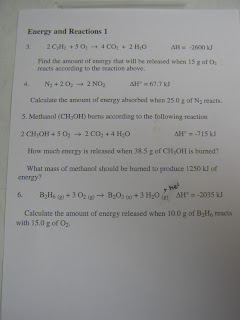Mr.Tucker had started the class off by going over the prelab, defining the terms listed on the worksheet such as, titration, equivalence point, and end point. If the definitions aren't visible in the picture below, I listed the definitions of the three words just above it.
Titration: A titration is a way to count the number of atoms, ions, or molecules that are present in a certain volume of liquid solution.
Equivalence Point: The equivalence point is the point at which all the acid neutralizes the base. (The number of moles of base equals the number of moles of acid.)
End Point: A dramatic color change occurs when a base neutralizes an acid, for example, when phenolphthalein is added to an acid solution and the base is added drop by drop, at a certain point the solution will turn pink and remain pink.

After we finished going over the Prelab, we then went on to the next page (Part 1-The Simulation) which has six questions that Mr. Tucker had given us the answers to.
Then finishing this sheet, we went on to Part 2-The Lab. We got with our lab groups and went to our lab tables. The purpose of this lab was to find out how much/ how many drops of NaOH (base) it takes to neutralize 10 drops of HCl (acid with 0.4M instead of 0.5M) with one drop of phenolphthalein (base indicator), also the concentration of NaOH. We did five trials on Friday, and did a sixth in class today.

After finishing all the trials, we were given an equation that enables us to find the concentration Of either an acid or a base, in our case we were solving for the base.
MAVA= MBVB or Macid x Drops acid (VA)= Mbase x Drops base (VB)
This part of the lab was assigned for homework.
 Some examples of the work below...
Some examples of the work below... 
Remember, the reaction occurring is HCl + NaOH ------> NaCl + H₂0!
































 Our homework for tonight is page 4 Heat Calculations 3 that we picked up in the beginning of class.
Our homework for tonight is page 4 Heat Calculations 3 that we picked up in the beginning of class.




 on journal page 4, remember when something is increased or decreased, you do the
on journal page 4, remember when something is increased or decreased, you do the 





